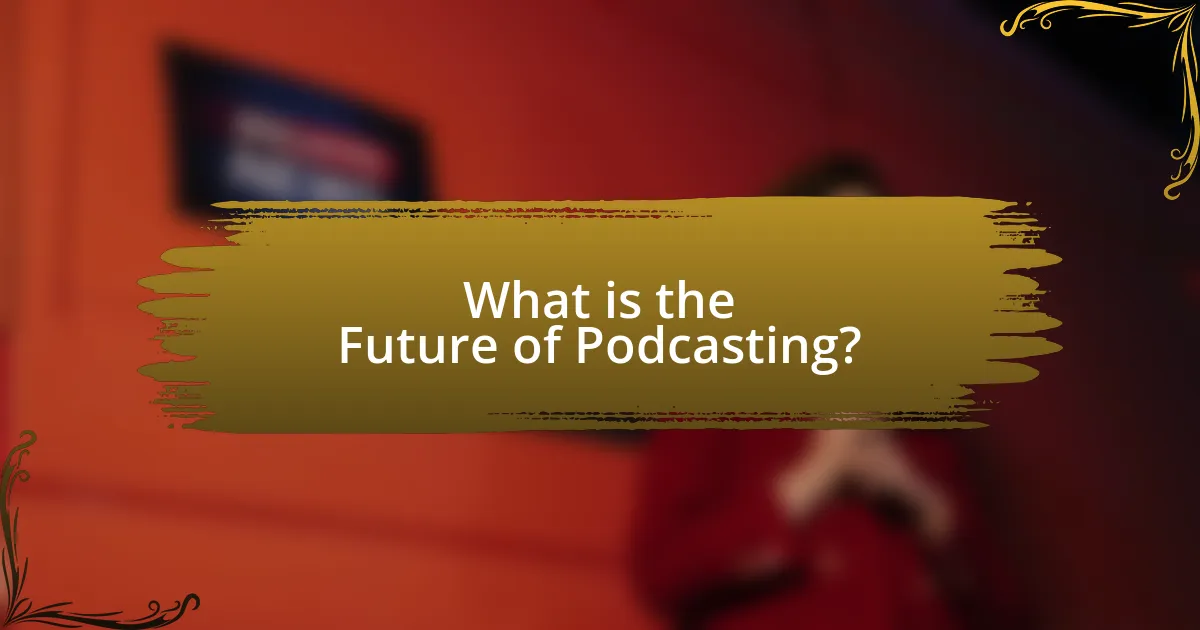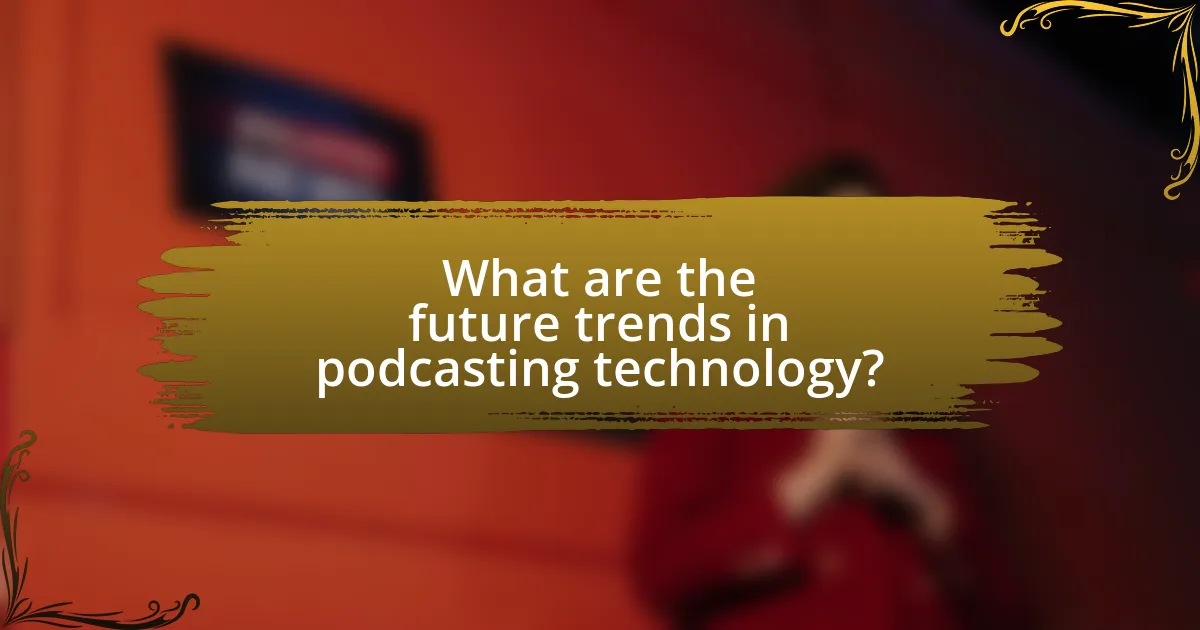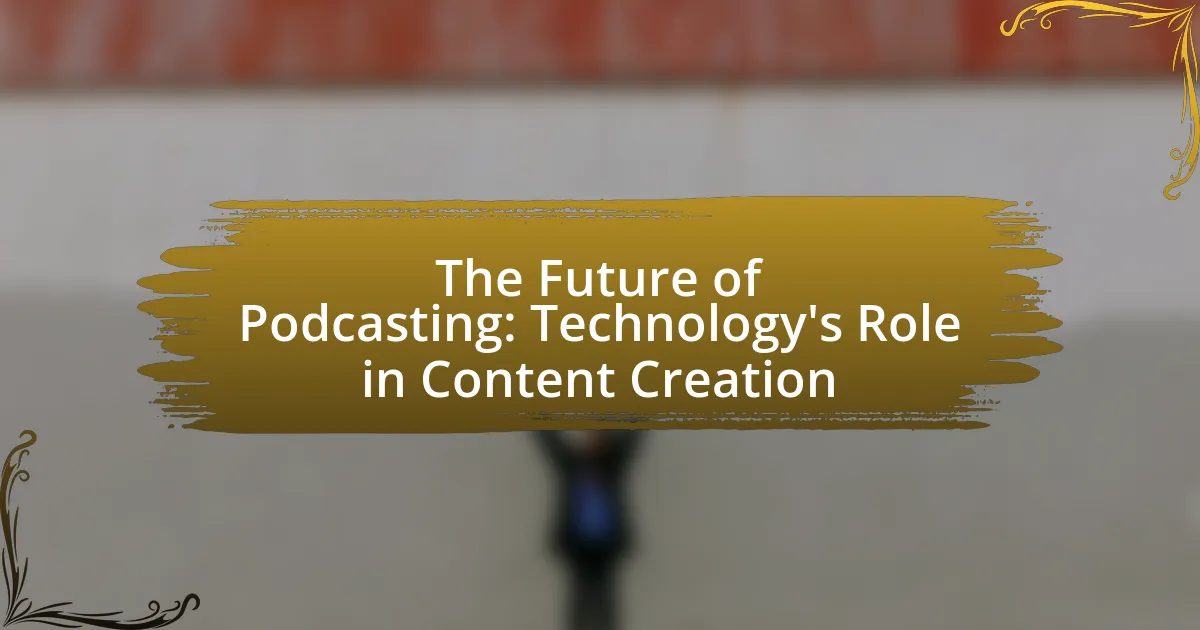The article focuses on the future of podcasting and the significant role technology plays in content creation. It highlights advancements such as artificial intelligence, improved audio quality, and enhanced interactivity that are shaping the podcasting landscape. Key trends include the rise of mobile technology, the impact of social media integration, and the growing popularity of subscription services. Additionally, the article discusses how these technological developments enhance listener experiences and engagement, while also providing best practices for podcasters to leverage these innovations effectively.

What is the Future of Podcasting?
The future of podcasting is characterized by increased interactivity and personalization, driven by advancements in technology. As artificial intelligence and machine learning improve, podcast platforms will offer tailored content recommendations, enhancing user engagement. According to a report by Edison Research, 41% of Americans aged 12 and older have listened to a podcast in the past year, indicating a growing audience that technology can further engage through features like voice-activated commands and augmented reality experiences. Additionally, the integration of social media and live streaming capabilities will allow for real-time audience interaction, making podcasting a more dynamic medium.
How is technology shaping the evolution of podcasting?
Technology is significantly shaping the evolution of podcasting by enhancing accessibility, improving production quality, and enabling innovative distribution methods. The rise of user-friendly recording and editing software, such as Audacity and GarageBand, allows creators to produce high-quality audio content without extensive technical skills. Additionally, advancements in hosting platforms like Anchor and Libsyn facilitate easier distribution and monetization, reaching wider audiences. According to a report by Edison Research, the number of monthly podcast listeners in the U.S. has grown to over 100 million, highlighting the impact of technology in expanding the podcasting landscape. Furthermore, the integration of artificial intelligence in content curation and recommendation systems personalizes listener experiences, driving engagement and retention.
What technological advancements are influencing podcast production?
Technological advancements influencing podcast production include improved audio editing software, enhanced recording equipment, and the rise of artificial intelligence tools. Audio editing software like Adobe Audition and Audacity allows creators to produce high-quality sound with user-friendly interfaces and advanced features. Enhanced recording equipment, such as USB microphones and portable recorders, has made it easier for podcasters to achieve professional sound quality. Additionally, artificial intelligence tools, such as automated transcription services and content generation algorithms, streamline the production process and enhance accessibility. These advancements collectively contribute to a more efficient and higher-quality podcasting landscape.
How do these advancements enhance listener experience?
Advancements in podcasting technology enhance listener experience by providing improved audio quality, personalized content delivery, and interactive features. Enhanced audio quality, achieved through advanced recording equipment and editing software, ensures that listeners enjoy clear and immersive sound, which is crucial for engagement. Personalized content delivery, facilitated by algorithms that analyze listener preferences, allows for tailored recommendations, making it easier for users to discover relevant podcasts. Interactive features, such as real-time feedback and audience participation tools, foster a sense of community and connection between creators and listeners, enriching the overall experience. These enhancements collectively contribute to a more engaging, enjoyable, and user-centric podcasting landscape.
Why is podcasting becoming increasingly popular?
Podcasting is becoming increasingly popular due to its accessibility and the rise of mobile technology. The proliferation of smartphones and portable devices allows users to listen to podcasts anytime and anywhere, making it a convenient medium for consuming content. According to Edison Research, as of 2023, over 80 million Americans listen to podcasts monthly, reflecting a significant increase in audience engagement. This growth is further fueled by the diverse range of topics available, catering to various interests and demographics, which enhances listener retention and attracts new audiences.
What demographic trends are driving podcast consumption?
Younger demographics, particularly Millennials and Gen Z, are driving podcast consumption due to their preference for on-demand audio content. According to Edison Research’s “The Infinite Dial 2023,” 62% of Americans aged 12-34 have listened to a podcast in the past month, highlighting the significant engagement of these age groups. Additionally, the rise of mobile technology and social media platforms has facilitated easier access to podcasts, further increasing their popularity among younger listeners. This demographic trend indicates a shift in media consumption habits, favoring flexibility and personalization in content delivery.
How does podcasting compare to other media formats?
Podcasting offers a unique blend of accessibility and intimacy compared to other media formats like television, radio, and written content. Unlike television, which requires visual engagement, podcasting allows listeners to consume content while multitasking, making it more versatile for daily routines. Additionally, podcasts foster a personal connection through voice, creating a sense of intimacy that written articles or videos may lack. According to Edison Research, as of 2023, 62% of Americans aged 12 and older have listened to a podcast, indicating its growing popularity and reach compared to traditional media formats. This accessibility and personal engagement position podcasting as a powerful medium in the evolving landscape of content creation.

What role does technology play in content creation for podcasts?
Technology is essential in content creation for podcasts as it facilitates recording, editing, distribution, and audience engagement. Advanced recording equipment and software enable high-quality audio capture, while editing tools streamline the production process, allowing creators to enhance their content efficiently. Furthermore, platforms like Anchor and Libsyn simplify distribution, making podcasts accessible to a wider audience. Analytics tools provide insights into listener behavior, helping creators tailor their content to meet audience preferences. According to a report by Edison Research, 75% of Americans are familiar with podcasting, highlighting the growing importance of technology in reaching and engaging listeners effectively.
How are recording technologies evolving for podcasters?
Recording technologies for podcasters are evolving through advancements in digital audio interfaces, mobile recording applications, and cloud-based editing tools. Digital audio interfaces are becoming more user-friendly and affordable, allowing podcasters to achieve professional sound quality without extensive technical knowledge. Mobile recording applications are enhancing portability and accessibility, enabling creators to record high-quality audio on-the-go. Additionally, cloud-based editing tools are streamlining the post-production process, allowing for collaborative editing and easier access to resources. These advancements reflect a trend towards democratizing podcast production, making it more accessible to a wider range of creators.
What are the latest tools available for high-quality audio recording?
The latest tools available for high-quality audio recording include the Shure MV7 microphone, the Zoom H6 Handy Recorder, and the Rode NT1-A condenser microphone. The Shure MV7 offers both USB and XLR outputs, making it versatile for various recording setups, while the Zoom H6 provides multi-track recording capabilities and interchangeable microphone capsules for enhanced audio quality. The Rode NT1-A is known for its low self-noise and wide frequency response, making it ideal for studio recordings. These tools are widely recognized in the podcasting community for their reliability and superior sound quality, as evidenced by numerous reviews and user testimonials.
How do mobile applications facilitate podcast creation?
Mobile applications facilitate podcast creation by providing user-friendly tools for recording, editing, and distributing audio content directly from smartphones. These applications often include features such as built-in microphones, sound editing capabilities, and easy integration with podcast hosting platforms, allowing creators to produce high-quality episodes without the need for expensive equipment or extensive technical knowledge. For instance, apps like Anchor and GarageBand enable users to record and edit their podcasts seamlessly, while also offering options for publishing episodes to various streaming services, thus streamlining the entire podcasting process.
What impact do editing and production technologies have on podcast quality?
Editing and production technologies significantly enhance podcast quality by improving audio clarity, consistency, and overall listener experience. Advanced software tools allow creators to eliminate background noise, balance sound levels, and add effects, resulting in a polished final product. For instance, studies show that podcasts with high production values, including professional editing, can increase listener retention rates by up to 30%. Furthermore, technologies such as automated transcription and audio enhancement algorithms streamline the production process, making it easier for creators to focus on content while ensuring high-quality output.
What software options are available for editing podcasts?
Software options available for editing podcasts include Audacity, Adobe Audition, GarageBand, and Reaper. Audacity is a free, open-source software that provides a range of editing tools suitable for beginners and professionals alike. Adobe Audition offers advanced features for audio editing and mixing, making it a preferred choice for those seeking high-quality production. GarageBand, available on macOS, is user-friendly and integrates well with Apple devices, catering to novice podcasters. Reaper is a cost-effective digital audio workstation that provides extensive customization and powerful editing capabilities. Each of these software options is widely used in the podcasting community, demonstrating their effectiveness in audio production.
How does automation in editing improve efficiency?
Automation in editing improves efficiency by significantly reducing the time and effort required for post-production tasks. Automated editing tools can quickly process audio and video files, applying consistent edits, noise reduction, and enhancements without manual intervention. For instance, studies show that automation can cut editing time by up to 50%, allowing creators to focus on content development rather than technical adjustments. This efficiency gain is crucial in the fast-paced environment of podcasting, where timely content delivery can enhance audience engagement and retention.

What are the future trends in podcasting technology?
Future trends in podcasting technology include enhanced interactivity, AI-driven content creation, and improved audio quality through advanced encoding techniques. Enhanced interactivity allows listeners to engage with content in real-time, such as choosing story paths or participating in live discussions, which can increase listener retention and satisfaction. AI-driven content creation utilizes machine learning algorithms to assist in scriptwriting, editing, and even voice synthesis, streamlining production processes and enabling creators to focus on storytelling. Improved audio quality is achieved through advancements in compression algorithms and streaming technologies, ensuring that listeners experience clearer sound regardless of their internet connection. These trends are supported by the growing adoption of smart speakers and mobile devices, which facilitate easier access to high-quality podcast content.
How is artificial intelligence influencing podcast content creation?
Artificial intelligence is significantly influencing podcast content creation by automating various aspects of production, enhancing personalization, and improving audience engagement. AI tools can streamline editing processes, such as noise reduction and audio enhancement, which allows creators to produce high-quality content more efficiently. For instance, platforms like Descript utilize AI to transcribe audio and enable easy editing, reducing the time spent on post-production. Additionally, AI algorithms analyze listener preferences and behaviors, enabling creators to tailor content to specific audiences, thereby increasing listener retention. According to a report by PwC, the podcasting industry is expected to grow to $1 billion by 2021, driven in part by these technological advancements.
What are the potential applications of AI in podcasting?
AI can enhance podcasting through applications such as automated transcription, content generation, personalized recommendations, and audio enhancement. Automated transcription services utilize AI to convert spoken content into text quickly and accurately, improving accessibility and searchability. Content generation tools can assist creators by suggesting topics, writing scripts, or even generating entire episodes based on user input. Personalized recommendation systems leverage AI algorithms to analyze listener preferences, thereby suggesting relevant podcasts and episodes, which can increase audience engagement. Additionally, AI-driven audio enhancement technologies can improve sound quality by reducing background noise and optimizing audio levels, resulting in a more professional listening experience. These applications demonstrate AI’s significant potential to transform the podcasting landscape by streamlining production processes and enhancing user experience.
How can AI enhance personalization for listeners?
AI enhances personalization for listeners by analyzing their preferences and behaviors to deliver tailored content. Through machine learning algorithms, AI can track listener habits, such as favorite genres, listening times, and engagement levels, allowing platforms to recommend specific podcasts that align with individual tastes. For instance, Spotify uses AI-driven algorithms to curate personalized playlists and podcast suggestions, resulting in increased user satisfaction and engagement. According to a study by McKinsey, personalized recommendations can lead to a 10-30% increase in user engagement, demonstrating the effectiveness of AI in enhancing listener experiences.
What emerging platforms are changing the podcast landscape?
Emerging platforms such as Spotify, Apple Podcasts, and YouTube are significantly changing the podcast landscape. Spotify has invested heavily in exclusive content and podcasting technology, acquiring companies like Anchor and Gimlet Media, which enhances its podcast offerings and user engagement. Apple Podcasts remains a dominant player, continually updating its features to improve user experience and discoverability. YouTube is increasingly becoming a popular platform for podcasts, allowing creators to reach wider audiences through video content, which has led to a surge in podcast viewership. These platforms are reshaping how content is created, distributed, and consumed in the podcasting industry.
How do social media platforms integrate podcasting features?
Social media platforms integrate podcasting features by allowing users to create, share, and discover audio content directly within their interfaces. For example, platforms like Facebook and Instagram have introduced audio clips and dedicated podcast sections, enabling users to upload episodes, engage with listeners through comments, and promote their shows via stories or posts. Additionally, Twitter has launched Spaces, which allows live audio conversations, further blending social interaction with podcasting. These integrations enhance user engagement and expand the reach of podcast creators, as evidenced by Spotify’s acquisition of podcast networks and its investment in exclusive content, which has significantly increased its user base and listening hours.
What role do subscription services play in the future of podcasting?
Subscription services are pivotal in shaping the future of podcasting by providing creators with sustainable revenue models. These services enable podcasters to monetize their content directly through listener subscriptions, which can lead to increased financial stability and creative freedom. According to a report by Edison Research, 29% of podcast listeners are willing to pay for exclusive content, indicating a growing market for subscription-based models. This shift allows creators to focus on high-quality production and niche content, fostering a diverse podcasting ecosystem.
What best practices should podcasters follow to leverage technology effectively?
Podcasters should utilize high-quality recording equipment and editing software to enhance audio clarity and production value. Investing in a good microphone and headphones ensures clear sound capture, while software like Audacity or Adobe Audition allows for professional editing, which can significantly improve listener experience. According to a 2021 report by Edison Research, 75% of podcast listeners prioritize audio quality, indicating that superior technology directly influences audience retention and satisfaction. Additionally, podcasters should leverage distribution platforms like Spotify and Apple Podcasts to maximize reach, as these platforms have millions of active users, providing greater visibility for content. Engaging with social media tools for promotion can also amplify audience interaction and growth, as studies show that podcasts promoted on social media see a 20% increase in listener engagement.
How can podcasters stay updated with technological advancements?
Podcasters can stay updated with technological advancements by regularly following industry news, participating in relevant online communities, and attending conferences or webinars focused on podcasting technology. Engaging with platforms like Podnews and listening to industry-specific podcasts can provide timely updates on new tools and trends. Additionally, joining forums such as Reddit’s podcasting community or Facebook groups dedicated to podcasters allows for sharing insights and experiences with peers. Research indicates that continuous learning and networking are crucial for adapting to rapid technological changes in the podcasting landscape.
What strategies can enhance audience engagement through technology?
Utilizing interactive elements such as polls, Q&A sessions, and live chats can significantly enhance audience engagement through technology. These strategies allow listeners to participate actively, fostering a sense of community and connection. For instance, platforms like Spotify and Clubhouse have integrated features that enable real-time interaction, which has been shown to increase listener retention and satisfaction. According to a study by Edison Research, 70% of podcast listeners prefer shows that incorporate audience interaction, highlighting the effectiveness of these technological strategies in boosting engagement.

Leave a Reply